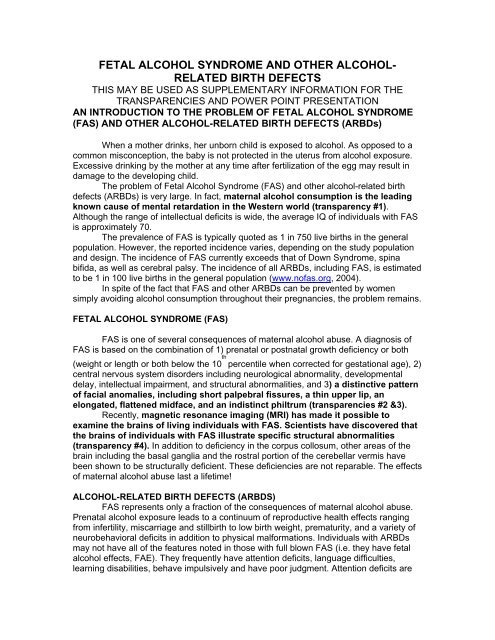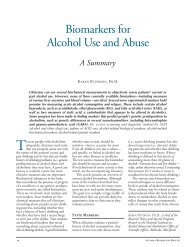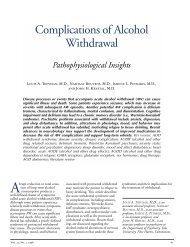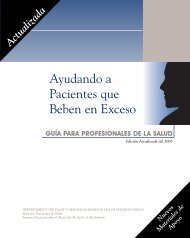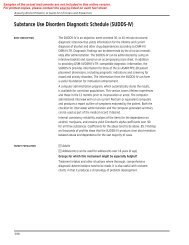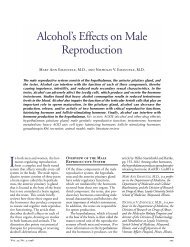Alcohol Syndrome (FAS) and Other Alcohol-Related Birth Defects
Alcohol Syndrome (FAS) and Other Alcohol-Related Birth Defects
Alcohol Syndrome (FAS) and Other Alcohol-Related Birth Defects
You also want an ePaper? Increase the reach of your titles
YUMPU automatically turns print PDFs into web optimized ePapers that Google loves.
FETAL ALCOHOL SYNDROME AND OTHER ALCOHOL-<br />
RELATED BIRTH DEFECTS<br />
THIS MAY BE USED AS SUPPLEMENTARY INFORMATION FOR THE<br />
TRANSPARENCIES AND POWER POINT PRESENTATION<br />
AN INTRODUCTION TO THE PROBLEM OF FETAL ALCOHOL SYNDROME<br />
(<strong>FAS</strong>) AND OTHER ALCOHOL-RELATED BIRTH DEFECTS (ARBDs)<br />
When a mother drinks, her unborn child is exposed to alcohol. As opposed to a<br />
common misconception, the baby is not protected in the uterus from alcohol exposure.<br />
Excessive drinking by the mother at any time after fertilization of the egg may result in<br />
damage to the developing child.<br />
The problem of Fetal <strong>Alcohol</strong> <strong>Syndrome</strong> (<strong>FAS</strong>) <strong>and</strong> other alcohol-related birth<br />
defects (ARBDs) is very large. In fact, maternal alcohol consumption is the leading<br />
known cause of mental retardation in the Western world (transparency #1).<br />
Although the range of intellectual deficits is wide, the average IQ of individuals with <strong>FAS</strong><br />
is approximately 70.<br />
The prevalence of <strong>FAS</strong> is typically quoted as 1 in 750 live births in the general<br />
population. However, the reported incidence varies, depending on the study population<br />
<strong>and</strong> design. The incidence of <strong>FAS</strong> currently exceeds that of Down <strong>Syndrome</strong>, spina<br />
bifida, as well as cerebral palsy. The incidence of all ARBDs, including <strong>FAS</strong>, is estimated<br />
to be 1 in 100 live births in the general population (www.nofas.org, 2004).<br />
In spite of the fact that <strong>FAS</strong> <strong>and</strong> other ARBDs can be prevented by women<br />
simply avoiding alcohol consumption throughout their pregnancies, the problem remains.<br />
FETAL ALCOHOL SYNDROME (<strong>FAS</strong>)<br />
<strong>FAS</strong> is one of several consequences of maternal alcohol abuse. A diagnosis of<br />
<strong>FAS</strong> is based on the combination of 1) prenatal or postnatal growth deficiency or both<br />
(weight or length or both below the 10 th<br />
percentile when corrected for gestational age), 2)<br />
central nervous system disorders including neurological abnormality, developmental<br />
delay, intellectual impairment, <strong>and</strong> structural abnormalities, <strong>and</strong> 3) a distinctive pattern<br />
of facial anomalies, including short palpebral fissures, a thin upper lip, an<br />
elongated, flattened midface, <strong>and</strong> an indistinct philtrum (transparencies #2 &3).<br />
Recently, magnetic resonance imaging (MRI) has made it possible to<br />
examine the brains of living individuals with <strong>FAS</strong>. Scientists have discovered that<br />
the brains of individuals with <strong>FAS</strong> illustrate specific structural abnormalities<br />
(transparency #4). In addition to deficiency in the corpus collosum, other areas of the<br />
brain including the basal ganglia <strong>and</strong> the rostral portion of the cerebellar vermis have<br />
been shown to be structurally deficient. These deficiencies are not reparable. The effects<br />
of maternal alcohol abuse last a lifetime!<br />
ALCOHOL-RELATED BIRTH DEFECTS (ARBDS)<br />
<strong>FAS</strong> represents only a fraction of the consequences of maternal alcohol abuse.<br />
Prenatal alcohol exposure leads to a continuum of reproductive health effects ranging<br />
from infertility, miscarriage <strong>and</strong> stillbirth to low birth weight, prematurity, <strong>and</strong> a variety of<br />
neurobehavioral deficits in addition to physical malformations. Individuals with ARBDs<br />
may not have all of the features noted in those with full blown <strong>FAS</strong> (i.e. they have fetal<br />
alcohol effects, FAE). They frequently have attention deficits, language difficulties,<br />
learning disabilities, behave impulsively <strong>and</strong> have poor judgment. Attention deficits are


